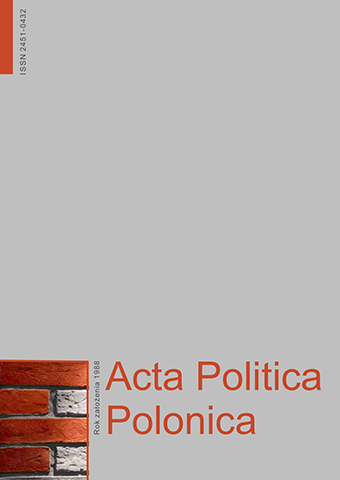
ISSN: 2451-0432
OAI
DOI: 10.18276/ap.2019.47-05




Issue archive /
1/2019 (47)
Agenda Miejska Unii Europejskiej. W poszukiwaniu miejsca dla władz miejskich w europejskiej policy-making
(Urban Agenda of the European Union. In search of a place for municipal authorities in European policy-making)
| Authors: |
Dariusz
Mącarz
Uniwersytet Wrocławski, Wydział Nauk Społecznych |
| Keywords: | urban policy urban agenda European Union governance |
| Data publikacji całości: | 2019 |
| Page range: | 12 (57-68) |
Abstract
Urban Agenda introduced in 2016 in the EU is the next step in deepening the urban dimension
of European policies. Inclusion of city representatives in the work on developing better solutions
for future policies affecting urban areas at all levels of EU governance is one of its key
elements. The article presents an outline of the evolution of the EU urban dimension, presents
the mechanism of managing the Urban Agenda and the method of work within the framework
of partnerships. It also focuses on the elements of intergovernmental and technocratic logic
present in the Agenda and refers it to the existing methods of public management in the EU.
The article analyzes as well types of cities involved in the work of partnerships.
Download file
Article file
Bibliography
| 1. | Barber, B. (2013). Gdyby burmistrzowie rządzili światem, Warszawa: Muza. |
| 2. | Castells, M. (2010). Społeczeństwo Sieci. Warszawa: Wydawnictwo Naukowe PWN. |
| 3. | Czapiewski, T. (2013). Pojęcie analizy sieci politycznych wobec rozwoju Multi-level Governance. W: J. Ruszkowski, |
| 4. | L. Wojnicz (red.), Multi-level governance w UE (s. 107–121). Szczecin–Warszawa: Instytut Politologii i Europeistyki |
| 5. | Uniwersytetu Szczecińskiego. |
| 6. | European Commission (1997). Communication from the Commission. Towards an urban agenda in the European |
| 7. | Union. COM(97)197 final. |
| 8. | Eurostat (2016). Urban Europe. Statistics on cities, towns and suburbs. Pobrane z: https://ec.europa.eu/eurostat/documents/ |
| 9. | 3217494/7596823/KS-01-16-691-EN-N.pdf/0abf140c-ccc7-4a7f-b236-682effcde10f (5.12.2018). |
| 10. | Glaeser, E. (2011). Triumph of the city: how our greatest invention makes us richer, smarter, greener, healthier, and happier. |
| 11. | New York: Penguin Press. |
| 12. | González Medina, M., Fedeli, V. (2015). Exploring European urban policy: Towards an EU-national urban agenda? |
| 13. | Gestión y Análisis de Políticas Públicas, 14, 7–22. 10.24965/gapp.v0i14.10287. |
| 14. | Grosse, T.G. (2008). Europa na rozdrożu. Warszawa: Instytut Spraw Publicznych. |
| 15. | Gruszczak, A. (2006). Otwarta metoda koordynacji w odniesieniu do swobody przepływu osób w Unii Europejskiej. |
| 16. | Warszawa: Centrum Europejskie Natolin. |
| 17. | Jadach-Sepioło, A. (2014). Ewolucja europejskiego stanowiska wobec polityki miejskiej w latach 1975–2007. Problemy |
| 18. | Rozwoju Miast 1–2 (6), 50–57. |
| 19. | Karta Lipska (2007). W: T. Majda, I. Mironowicz (red.) (2017). Manifesty urbanistyczne w poszukiwaniu współczesnego |
| 20. | modelu miasta (s. 116–122). Warszawa: Towarzystwo Urbanistów Polskich. |
| 21. | Komisja Europejska (2008). Cities of Tomorrow. Challenges, visions, ways forward. Pobrane z: https://ec.europa.eu/ |
| 22. | regional_policy/sources/docgener/studies/pdf/citiesoftomorrow/citiesoftomorrow_final.pdf (1.12.2018). |
| 23. | Komisja Europejska (2014). Komunikat Komisji do Parlamentu Europejskiego, Rady, Europejskiego Komitetu Ekonomiczno- |
| 24. | Społecznego i Komitetu Regionów. Miejski wymiar polityki UE – kluczowe elementy agendy miejskiej |
| 25. | UE. COM(2014) 490 final. |
| 26. | Komisja Europejska (2014). Zintegrowane działania na rzecz zrównoważonego rozwoju obszarów miejskich. Pobrane |
| 27. | z: https://ec.europa.eu/regional_policy/sources/docgener/informat/2014/urban_pl.pdf (10.12.2018). |
| 28. | Komisja Europejska (2017). Raport Komisji Europejskiej do Rady Europejskiej ws. Agendy Miejskiej dla UE. |
| 29. | COM(2017) 657 final. |
| 30. | Lackowska, M. (2009). Zarządzanie wielopoziomowe – nowe zastosowania koncepcji, Zarządzanie Publiczne, 3 (9), |
| 31. | 53–67. |
| 32. | Pakt Amsterdamski. Agenda Miejska Unii Europejskiej (2017). W: T. Majda, I. Mironowicz, Manifesty urbanistyczne |
| 33. | w poszukiwaniu współczesnego modelu miasta (s. 131–140). Warszawa: Towarzystwo Urbanistów Polskich. |
| 34. | Potjer, S., Hajer, M. (2017). Learning with Cities, Learning for Cities. The Golden Opportunity of the Urban Agenda |
| 35. | for the UE. Pobrane z: https://www.uu.nl/sites/default/files/essay-urbanfuturesstudio-12juli-web.pdf (30.11.2018). |
| 36. | Protokół (nr 2) w sprawie stosowania zasad pomocniczości i proporcjonalności. Dz. Urz. 115, 09.05.2008 P. 0206–0209. |
| 37. | Rezolucja Parlamentu Europejskiego z dnia 23 czerwca 2011 r. w sprawie europejskiej agendy miejskiej i jej przyszłości |
| 38. | w polityce spójności (2010/2158(INI). |
| 39. | Ruszkowski, J. (2007). Wstęp do studiów europejskich. Warszawa: Wydawnictwo Naukowe PWN. |
| 40. | Traktat o Funkcjonowaniu Unii Europejskiej (wersja skonsolidowana). Dz.Urz. UE C 202 z 7.06.2016, s. 47. |
| 41. | Traktat o Unii Europejskiej. Dz.U. z 2004 r. Nr 90, poz. 864/30 ze zm. |
| 42. | Working Programme of the Urban Agenda for the EU. Draft version. Pobrane z: https://ec.europa.eu/regional_policy/ |
| 43. | sources/policy/themes/urban-development/agenda/urban-agenda-working-programme.pdf (20.11.2018). |